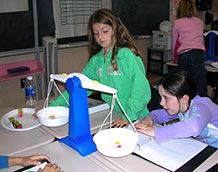What does a pan balance tell us about the weight order of the cubes?
2. Check the weight order

Before distributing the pan balances, show students how to use the sliders to level the pans. Point out the device that indicates that the pans are level, and make sure students know how to read it. Let students know that the balances are scientific instruments and that they must handle them carefully.
Post the table from the last session alongside the new table. Have each group arrange its cubes in the weight order they decided on last time, then have them check that order using the pan balance. Ask them to record their findings both in their notebooks and in the class table.
Note: If students have not had much prior experience with a pan balance, allow time for them to explore how a balance reacts to objects in the pans and remind them to work gently. Keeping these elementary school balances well adjusted and in good working condition is important because they are not as consistent or accurate as more expensive instruments. Help students get in the habit of checking the balances prior to each use to see if any adjustments are necessary.
| Group | Least Weight → Most Weight | |||||||
|---|---|---|---|---|---|---|---|---|
| 1 | ||||||||
| 2 | ||||||||
| 3 | ||||||||
| 4 | ||||||||
| 5 | ||||||||
| Class Order | ||||||||
Students may struggle a bit if their predicted order is proven incorrect. Encourage them to go slow, comparing one pair of cubes at a time, taking careful note of which cube is heavier — perhaps also noting whether it is “much heavier” or ”a little heavier“ — then moving on to another pair.
When all the data has been recorded, ask the class to look for discrepancies in the new, measured, orderings. Have them resolve any differences using the pan balance, then record the final result in the row labeled “Class Order.” Students should also record the final order in their notebooks.
The correct order from least weight to most weight is: Pine, Oak, Nylon, Acrylic, PVC, Aluminum, Steel, Copper.



